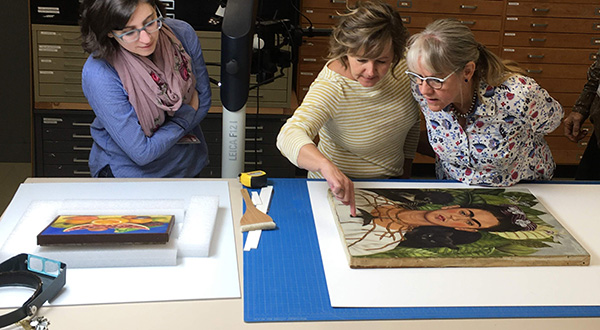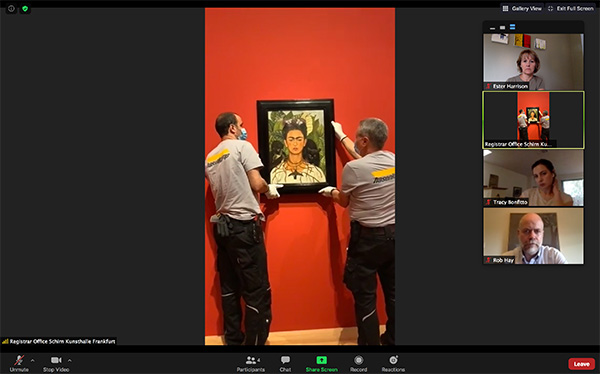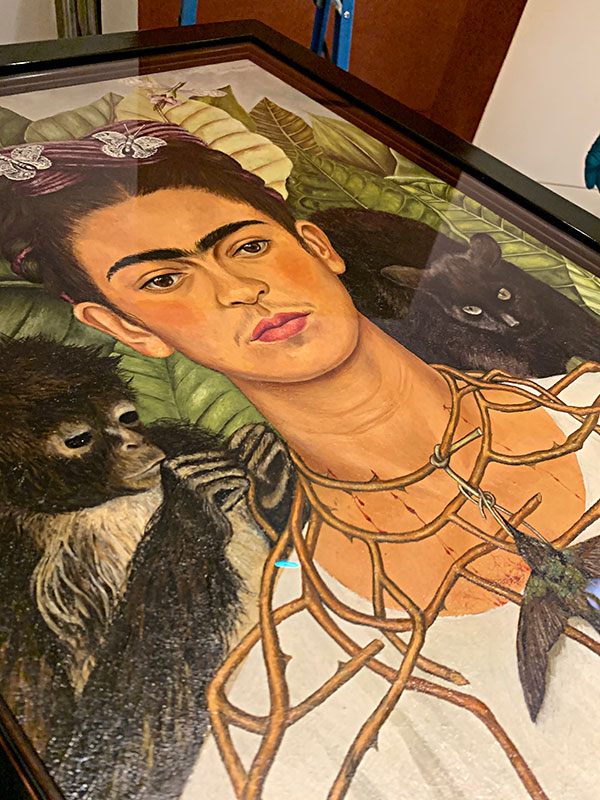When you see a favorite work of art on display in a traveling exhibition, do you ever wonder about its journey to that point? Under ideal conditions, it is a lengthy process involving museum staff and vendors from around the world. However, during a global pandemic, the role of a well-seasoned registrar proves to be more critical than ever when it comes to putting one of Frida Kahlo’s most iconic paintings on view.
In this Q & A, Harry Ransom Center Registrar Ester Harrison gives us a behind-the-scenes look at her integral role in the care and stewardship of Kahlo’s 1940 Self-Portrait with Thorn Necklace and Hummingbird.
Randi Ragsdale: Can you give a brief overview of what your role as registrar entails?
Ester Harrison: I have been a registrar for about 25 years now. What a museum registrar does, broadly speaking, for fine art is what a librarian does with books: manages incoming and outgoing loans in collaboration with other museums and institutions. Incoming loans are items that our curators want to borrow from other museums to supplement an exhibition. But, with such a large permanent collection at the Ransom Center, outgoing loans are the majority of what I manage.
Outgoing loans involve an extensive process that includes reviewing loan requests with our loan assessment staff, negotiating contracts and schedules with borrowing institutions, completing condition reports, and working with our own conservators, preparators, and curators to review and prepare items for shipment. I work with fine-art shipping specialists to coordinate the process to get the works from the Center to places all over the world. Sometimes a representative of the Center has to travel with the objects, and I arrange that as well. In other words, I facilitate an involved, complex process, so it is similar to being a project manager.
The same skills apply to my work in support of acquisitions. Once a donation or purchase has been made, I arrange packaging and shipping with the donor or seller to get the items to the Center. And l also serve on a lot of committees related to collections care.

Self-Portrait with Thorn Necklace and Hummingbird has a more demanding schedule than some of the other items on display at the Center, and I am responsible for knowing where the painting is and when it will be available for view, or not. I also help field image requests and loan requests from other museums. These requests happen frequently for the Kahlo painting!
This painting is occasionally out on loan or is put away for conservation reasons. A painting like this can’t be exposed and in light all day every day, year after year, and it sometimes needs a rest. Even though it is unfortunate that people couldn’t come see the painting at the Center for a long time during the pandemic, it was actually great for the preservation of the work. Security and care of our collections continued during the closure, but for months the painting was basically in the dark and not exposed to light, which helps preserve the overall condition of the work.
Most importantly, what I do when the Kahlo painting is at the Center is support the curators, conservators, and preparators to care for and protect the painting. It’s a very popular and important painting in a very public space, and in various ways all of us at the Ransom Center have a responsibility to care for this work of art.

How has the Covid-19 pandemic changed how you care and manage the work while on loan?
The Kahlo painting was slated to go to the Louisiana Museum of Modern Art in Denmark in July 2020. Normally we send a representative to travel with the Kahlo painting, review its condition with the borrowing institution, and oversee the entire installation. Due to travel bans, we couldn’t send a person with the painting through Frankfurt and Denmark, so we temporarily pivoted to a newer technique of virtual couriering for the loan.
In a loan assessment, reviewing the museum’s facility report and getting to know your colleagues at a borrowing institution is crucial. For a loan to be approved in the first place, you trust their staff and their facilities with an important painting. That relationship was crucial to the success of having to do this work remotely, online. This meant finding a lot of new ways of working: up at 2 in the morning to get video confirmation of the painting’s safe arrival, watching the installation happen over Zoom, and providing more security than normal as a safeguard. We also had to do a lot more preparation on our end so that we could ask all the right questions when we did have time with the borrowing museum’s staff. Fortunately, the Louisiana Museum is an excellent institution with a painting conservator, so they were the best possible partner for our first virtual courier experience.

Being able to work intimately with that painting and examine it up close is a privilege that I don’t take for granted. It is just as stunning up close in a lab as it is displayed in an exhibition. I absolutely love the chance to see Kahlo’s brushstrokes and find new details like the direction of the brushstrokes, layers of color, or a paintbrush fiber. Details like that bring a deeper level of life and history to the painting and remind me that it’s not just a beautiful painting but it captured a real moment in time. Kahlo’s brushstrokes and layers were these purposeful things that she did. And so that, to me, is just so exciting and thrilling to see.
I’m not an art historian or a curator, but another thing that I really love about this particular painting is its depth of meaning. Kahlo made only about 152 paintings that survive today, and just under 60 of these are self-portraits. But this particular one just seems to jump off the canvas. I absolutely love that. And I’m a big animal lover. So the cat and the monkey and the butterflies—to me, make it even more engaging.

Artwork featured:
Frida Kahlo (Mexican, 1907–1954), Untitled [Self-portrait with thorn necklace and hummingbird], 1940. Oil on canvas mounted to board. Nickolas Muray Collection of Mexican Art, 66.6 © 2020 Banco de México Diego Rivera Frida Kahlo Museums Trust, Mexico, D.F. / Artists Rights Society (ARS), New York.
Frida Kahlo (Mexican, 1907–1954), Untitled [Still life with parrot and fruit], 1951. Oil on canvas. Nickolas Muray Collection of Mexican Art, 66.7. © 2020 Banco de México Diego Rivera Frida Kahlo Museums Trust, Mexico, D.F. / Artists Rights Society (ARS), New York.
Image Featured
Ester Harrison, Art Registrar for Loans & Exhibitions
